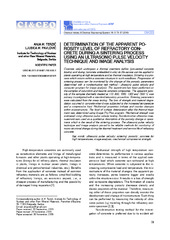Приказ основних података о документу
Determination of the apparent porosity level of refractory concrete during a sintering process using an ultrasonic pulse velocity technique and image analysis
| dc.creator | Terzić, Anja | |
| dc.creator | Pavlović, Ljubica | |
| dc.date.accessioned | 2022-04-18T15:03:08Z | |
| dc.date.available | 2022-04-18T15:03:08Z | |
| dc.date.issued | 2010 | |
| dc.identifier.issn | 1451-9372 | |
| dc.identifier.uri | http://rims.institutims.rs/handle/123456789/115 | |
| dc.description.abstract | Concrete which undergoes a thermal treatment before (pre-casted concrete blocks) and during (concrete embedded in-situ) its life-service can be applied in plants operating at high temperature and as thermal insulation. Sintering is a process which occurs within a concrete structure in such conditions. Progression of sintering process can be monitored by the change of the porosity parameters determined with a nondestructive test method - ultrasonic pulse velocity and computer program for image analysis. The experiment has been performed on the samples of corundum and bauxite concrete composites. The apparent porosity of the samples thermally treated at 110, 800, 1000, 1300 and 1500 degrees C was primary investigated with a standard laboratory procedure. Sintering parameters were calculated from the creep testing. The loss of strength and material degradation occurred in concrete when it was subjected to the increased temperature and a compressive load. Mechanical properties indicate and monitor changes within microstructure. The level of surface deterioration after the thermal treatment was determined using Image Pro Plus program. Mechanical strength was estimated using ultrasonic pulse velocity testing Nondestructive ultrasonic measurement was used as a qualitative description of the porosity change in specimens which is the result of the sintering process. The ultrasonic pulse velocity technique and image analysis proved to be reliable methods for monitoring of micro-structural change during the thermal treatment and service life of refractory concrete. | en |
| dc.publisher | Savez hemijskih inženjera, Beograd | |
| dc.relation | info:eu-repo/grantAgreement/MESTD/MPN2006-2010/19012/RS// | |
| dc.relation | info:eu-repo/grantAgreement/MESTD/MPN2006-2010/16004/RS// | |
| dc.rights | openAccess | |
| dc.rights.uri | https://creativecommons.org/licenses/by-nc-nd/4.0/ | |
| dc.source | Chemical Industry and Chemical Engineering Quarterly / CICEQ | |
| dc.subject | ultrasonic pulse velocity | en |
| dc.subject | sintering | en |
| dc.subject | porosity | en |
| dc.subject | mechanical compressive strength | en |
| dc.subject | image analysis | en |
| dc.subject | concrete for high temperatures | en |
| dc.title | Determination of the apparent porosity level of refractory concrete during a sintering process using an ultrasonic pulse velocity technique and image analysis | en |
| dc.type | article | |
| dc.rights.license | BY-NC-ND | |
| dc.citation.epage | 87 | |
| dc.citation.issue | 1 | |
| dc.citation.other | 16(1): 79-87 | |
| dc.citation.rank | M23 | |
| dc.citation.spage | 79 | |
| dc.citation.volume | 16 | |
| dc.identifier.doi | 10.2298/CICEQ1000012T | |
| dc.identifier.fulltext | http://rims.institutims.rs/bitstream/id/9/112.pdf | |
| dc.identifier.wos | 000279150700009 | |
| dc.type.version | publishedVersion |

